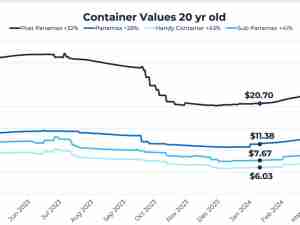Organic Feed Boom Means U.S. Cows Feast on Romanian Corn Instead
By: Megan Durisin | Apr 13 2016 at 06:00 PM | International Trade | Maritime
America may export more grain to feed cattle, pigs and poultry than any other country, but it’s losing share in its own backyard.
Because most of the corn and soybeans harvested across the Midwest come from genetically modified seed and use crop chemicals shunned by the organic industry, an increasing amount of specialty grain used to produce organic milk, eggs and meat industry is being imported from places like Romania and India. Purchases more than doubled last year and are rising again this year, government data show.
While organic feed remains a tiny portion of the U.S. grain market, it is growing rapidly. Consumers have tripled spending on organic food over the past decade to more than $35 billion in 2014, the industry estimates. Demand for specialty grain to feed dairy cows, hogs and egg-laying hens is out-pacing domestic harvests, so importers are taking advantage of a strong dollar and cheap freight to buy more from overseas.
“Every year, demand gets further away from supply here in the United States,” said Lynn Clarkson, president of Clarkson Grain Co., a supplier of organic and non-GMO corn and soybeans in Cerro Gordo, Illinois. “If you have market demand, it’ll be satisfied by somebody. I’d much rather see it being satisfied by domestic farmers.”
Imports of organic corn more than tripled last year to 303,645 metric tons, mostly from Romania and Turkey, U.S. Department of Agriculture data show. Purchases in January and February were five times what they were a year earlier. Organic-soybean imports—mainly from India and Ukraine—rose 45 percent to 317,284 tons, and in the first two months of 2016 were double their year-earlier levels, USDA data show. The total value of imported specialty corn and soybeans last year was $353.5 million.
Organic-milk sales have tripled since 2007, now accounting for 5 percent of the U.S. milk market. That’s created “chronic shortages of feed grains” at organic dairies, the USDA said in a February presentation. In the week ended March 19, 420,624 organic chickens were slaughtered, an increase of 22 percent from a year earlier, government data show. Over that same period, weekly egg output jumped 36 percent. Some of the specialty grains are also used in snack foods like organic tortilla chips.
Crop Premium
With demand growing, organic crops fetch a premium to conventional supplies. The spot prices for organic feed corn averaged $8.06 a bushel in week ended March 26, compared with $3.77 for the grain traded Tuesday on the Chicago Board of Trade. Organic soybeans averaged $17.04 a bushel in the week ended April 9, compared with $9.5575 on the CBOT.
Despite the premium, organic feed remains a tiny fraction of the U.S. grain supply. As of 2014, only 0.2 percent of domestic corn and soybean fields were devoted to organic varieties. That’s partly because of the costs associated with ditching GMO seeds as well as many of the fertilizers and crop chemicals most growers use.
Average yields for organic crops tend to be lower, and there’s increased risk of damage from pests, diseases and weeds. It also takes three years to transition from conventional crops to organic, during which costs will be higher and the harvested grain won’t command as much of a premium.
There are programs aimed at helping farmers make the transition. The Organic Trade Association and the Sustainable Food Lab are seeking to promote more planting through the U.S. Organic Grain Collaboration, which counts Whole Foods Market Inc., Clif Bar and General Mills Inc. as members.
“A lot of the buyers are willing to pay a little bit of a premium through the transition, and then the reward for them on the other side is that there’s new organic acreage coming into production,” said Kellee James, founder of Mercaris, a provider of market data and trading for organic, non-GMO and certified agricultural commodities. “There’s a recognition among buyers that they like to support domestic growers. All those dairy cows have got to eat something. If imports dried up tomorrow, I think the industry would be in real trouble.”
Planting More
Ardent Mills, the largest U.S. wheat miller, says it will double organic wheat planting by 2019. This year, the USDA expanded crop-insurance options for producers transitioning to organic.
At Clarkson Grain, the company is working on a certification program that pays farmers a premium for crops grown after one year using organic methods. Buyers might include chicken and hog farmers also working to transition their operations to organic, said George Kalogridis, the program coordinator.
“In the past, there has been trouble getting feed and having a consistent, affordable supply,” said Miranda Leis, feed-program operations manager for Organic Valley, a La Farge, Wisconsin-based cooperative whose members include about 1,800 dairy, egg, produce and grain farms. “Now there’s considerably more availability. Prices have come down, which is beneficial for the livestock members purchasing the feed, but it’s harder for the grain farmers who are trying to make a living selling that. It’s a pretty typical dynamic and it’s a tough one.”










